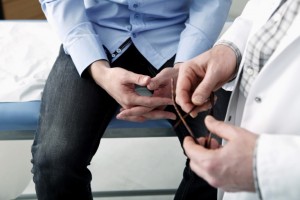Could Home Remedies Help With Your Trigeminal Neuralgia Pain?
 Trigeminal neuralgia can cause what some sufferers have described as blinding pain in the cheek, jaw, forehead, eye, and teeth on one side of the face. Pain can affect both sides of the face, but this is very rare and pain symptoms will affect only one side of the face at a time. The shooting pains have been likened to an electrical shock and an episode of trigeminal neuralgia pain can last up to two minutes.
Trigeminal neuralgia can cause what some sufferers have described as blinding pain in the cheek, jaw, forehead, eye, and teeth on one side of the face. Pain can affect both sides of the face, but this is very rare and pain symptoms will affect only one side of the face at a time. The shooting pains have been likened to an electrical shock and an episode of trigeminal neuralgia pain can last up to two minutes.
Trigeminal neuralgia treatment often involves medications or surgery. Stereotactic body radiation therapy (SBRT) can treat trigeminal neuralgia pain in a safe and non-invasive way by damaging the nerve responsible for the pain. It can take several weeks for SBRT to effectively relieve pain and symptoms can recur — although if necessary, SBRT can easily be repeated to achieve a more complete treatment. While you’re waiting for treatment to take full effect, you can try some home remedies to try and reduce trigeminal neuralgia pain by using heat, cold, or pressure.
Apply Heat or Cold to the Painful Area
Many people find relief from trigeminal neuralgia pain by applying heat to the affected area. You can do this locally by pressing a hot water bottle or other hot compress to the painful spot. Heat a beanbag or warm a wet washcloth in the microwave for this purpose. You can also try taking a hot shower or bath. If one is available, sit in a hot sauna.
Cold may also help relieve the pain, although you’ll obviously want to avoid this remedy if you’re one of the many trigeminal neuralgia sufferers for whom cold triggers symptoms. But if you think applying cold to the affected area might help relieve your symptoms until you can get SBRT or while you’re waiting for it to take effect, you can use an ice pack wrapped in a thin towel or pillowcase to numb the painful area. Keep the cold in contact with the affected area for about 30 seconds or until the area begins to feel numb. Some trigeminal neuralgia sufferers find that switching between the hot and cold compresses helps more.
 Apply Pressure to the Painful Area
Apply Pressure to the Painful Area
While many people find that a light touch — often as light as a gentle breeze wafting over their skin — can trigger trigeminal neuralgia symptoms, they also find that applying pressure to the area can help relieve symptoms. Use your entire hand to press on the affected area. You may need to apply a reasonable amount of pressure in order to get results.
Know Your Triggers
The more you know about what triggers your trigeminal neuralgia pain, the better equipped you’ll be to avoid those triggers and completely escape painful symptoms more often. Some common triggers include eating, talking, brushing teeth, cold, and light touches to the face. Things you wouldn’t expect can trigger trigeminal neuralgia pain, too. One woman reported that peppermint candy triggered her symptoms. If you can’t figure out what’s causing your pain, it may be helpful to keep a pain diary in which you record key details of your environment and activity in order to look for common threads among different symptom flare-ups.
While home remedies may not be capable of completely curing trigeminal neuralgia symptoms, they can be very useful for people who are waiting for treatment or who still have to make it through the recovery period in which symptoms gradually recede after SBRT. No matter where you fall on the spectrum, you’ll be glad to experience relief from your trigeminal neuralgia pain.
More
Quit Smoking to Improve Your Prostate Cancer Treatment Outcomes
 According to the results of a new study, men who smoke during prostate cancer treatment are not only more likely to experience treatment side effects, they’re also more likely to experience a recurrence or even die from prostate cancer.
According to the results of a new study, men who smoke during prostate cancer treatment are not only more likely to experience treatment side effects, they’re also more likely to experience a recurrence or even die from prostate cancer.
While men who have never smoked before in their lives run the least risk of experiencing prostate cancer treatment side effects, cancer recurrence, or death, the study found that even men who quit smoking right before beginning cancer treatment enjoyed better treatment outcomes than those who continued smoking throughout treatment.
Smoking Makes Prostate Cancer Treatment Less Effective
The study, performed by researchers from New York City’s Memorial Sloan Kettering Cancer Center and published in the journal BJU International, examined the effects of smoking history among a group of 2,358 patients who received external beam radiotherapy for prostate cancer between 1988 and 2005. 2,156 of the study participants had some kind of smoking history. Researchers divided the patients into four categories: never smokers, current smokers, former smokers, and current smoking status unknown. Even those participants who quit smoking right before beginning prostate cancer treatment were included in the “former smoker” category.
The researchers followed up with the study participants eight years after they received treatment. They found that patients who smoked during the cancer treatment had a 40 percent higher risk of relapse. Those who smoked during treatment were also twice as likely to experience prostate cancer metastasis and to die from prostate cancer, when compared to those who had never smoked.
 Patients who were considered former smokers under the terms of the study also had a slightly elevated risk of cancer recurrence, metastasis, and death, but their risks were somewhat lower than those of patients who smoked throughout cancer treatment. Ten years later, only about 52 percent of patients who smoked throughout treatment had not suffered a recurrence of prostate cancer, while 63 percent of former smokers and 66 percent of never smokers were still in the clear.
Patients who were considered former smokers under the terms of the study also had a slightly elevated risk of cancer recurrence, metastasis, and death, but their risks were somewhat lower than those of patients who smoked throughout cancer treatment. Ten years later, only about 52 percent of patients who smoked throughout treatment had not suffered a recurrence of prostate cancer, while 63 percent of former smokers and 66 percent of never smokers were still in the clear.
While today’s patients can choose from a far wider range of prostate cancer treatment options, external beam radiotherapy remains one of the oldest treatments for the disease. There is no reason to believe that the impact of smoking on the efficacy of other prostate cancer treatments, like stereotactic body radiation therapy (SBRT), would be any different than its impact on the efficacy of external beam radiotherapy. The study authors believe that smoking could contribute to the formation of more aggressive cancer tumors. They also speculate that smoking during cancer treatment could interfere with treatment by lowering oxygen levels within tumor cells, making them less susceptible to the effects of radiation.
In addition to an enhanced risk of cancer recurrence, metastasis, and death, current and former smokers involved in the study also experienced a greater risk of a range of urinary side effects. These side effects included urinary incontinence, urinary toxicity, bladder hemorrhage, and urinary retention.
If you want to improve your chances of a good treatment outcome for prostate cancer, you might want to consider quitting smoking. While researchers don’t yet fully understand the relationship between smoking and prostate cancer, new evidence suggests that smoking during treatment can make treatment less effective. If you’re a smoker who’s already been diagnosed with prostate cancer, it’s not too late — quitting smoking can still make a difference, even if you do it right before you start treatment.
More
How to Deal With Physical Changes After Cancer Treatment Ends
 Even after cancer treatment ends, you may find that you are still coping with physical changes related to treatment. These changes can range from reduced strength and endurance to lasting fatigue, pain, weight changes, and sexual changes.
Even after cancer treatment ends, you may find that you are still coping with physical changes related to treatment. These changes can range from reduced strength and endurance to lasting fatigue, pain, weight changes, and sexual changes.
While you may be able to counteract many of these lasting side effects with regular exercise, good nutrition, and other positive lifestyle changes, many side effects may linger for months or years after treatment ends, and it’s important to know how to cope.
Fatigue
No matter what kind of cancer you’ve suffered or what kind of treatment you’ve received, you may experience fatigue for a long time after your treatment ends. This kind of fatigue doesn’t go away with sleep. Though researchers don’t yet understand what causes treatment-related fatigue in cancer patients, it may occur due to poor nutrition, dehydration, anemia, pain, and depression.
Gentle exercise, relaxation, pain control, good nutrition, and drinking more fluids can help combat fatigue. Ask your treatment team about ways to fight fatigue. The causes of fatigue in people who have finished cancer treatment are different from the causes of fatigue in people who are still receiving treatment, so if you experienced fatigue during treatment, don’t be surprised if the solutions change.
Pain
Lingering pain may occur due to nerve damage caused by chemotherapy or damage to the skin caused by radiation therapy. Surgery scars can also cause pain after treatment ends. Some therapies for post-treatment pain include:
- Antidepressants or narcotic painkillers
- Acupuncture
- Physical therapy
- Braces
- Yoga
- Meditation
- Hypnosis
- Nerve blocks or other surgery
You can lower your risk of post-treatment pain with SBRT, a form of radiation therapy that minimizes damage to healthy tissue to reduce or eliminate complications.
 Weight Changes
Weight Changes
Some kinds of cancer therapy can cause weight gain, and after treatment, survivors find that it’s even harder than it should be to lose the weight because normal methods of weight loss don’t work. Chemotherapy can cause patients to lose muscle tissue and gain fatty tissue. Other survivors struggle with the opposite problem — they lose weight and can’t gain it back.
If you’re trying to lose weight after cancer treatment, you may want to try a combination of strength-training exercises and a healthy, low-calorie diet. If you want to gain more weight after cancer treatment, you may want to try:
- Eating several smaller meals instead of three larger ones.
- Eating more of your favorite foods.
- Making your meals look attractive.
- Using sauces, savory vegetables, and other seasonings to add flavor to foods.
Sexual Changes
Sexual changes are common after cancer treatment, especially among people who have had breast, prostate, or other reproductive cancer treatment. Survivors report losing interest in sex because of changes in body image, fatigue, pain, or simply a lowered sex drive. Others experience physical problems that make it harder to be intimate. Whatever the problem, it’s important that you ask your doctor about medication, counseling, or other therapies that can help resolve it. A sex therapist may also be able to help you and your partner come up with solutions.
Physical changes like pain and fatigue can persist for months after cancer treatment ends — some changes may last even longer. While it’s easy to get discouraged in the face of lingering cancer treatment side effects, try not to let these physical changes get you down. With time and a little creativity, you’ll soon find ways to enjoy yourself in spite of any lasting treatment side effects — and you may even find that most side effects do go away eventually, even if it takes a while.
More
10 Years of Use Proves the Safety and Efficacy of SBRT for Lung Cancer
 According to researchers from the Cleveland Clinic Foundation, a decade of lung cancer treatment with SBRT has proven that this focused radiation therapy is not only effective for controlling the growth and spread of lung cancer, it can also limit radiation exposure for the patient. The researchers tracked the results of SBRT for inoperable, early-stage lung cancer from 2003 to 2013. During that time, a mere 13 percent of the patients studied demonstrated any side effects, and even among those that did, symptoms were usually minimal.
According to researchers from the Cleveland Clinic Foundation, a decade of lung cancer treatment with SBRT has proven that this focused radiation therapy is not only effective for controlling the growth and spread of lung cancer, it can also limit radiation exposure for the patient. The researchers tracked the results of SBRT for inoperable, early-stage lung cancer from 2003 to 2013. During that time, a mere 13 percent of the patients studied demonstrated any side effects, and even among those that did, symptoms were usually minimal.
50-in-5 Regimen
For the purposes of the study, patients received what the researchers dubbed the “50-in-5 regimen” of SBRT, which consists of a total of 50 Gy of focused radiation delivered over the course of five sessions. Between October 2003 and December 2012, 300 patients received the 50-in-5 regimen to treat a total of 340 non-small cell lung cancer lesions. The average patient was 74 years old and over half the patients studied were women. A little more than 18 percent were cigarette smokers, although most of the patients were considered inoperable for other reasons.
The majority of the patients only needed a single course of SBRT for lung cancer treatment. Treatments were administered daily over a five-day period. Fifteen percent of the patients needed one or more additional courses of SBRT because their cancer came back. The short course of treatment with SBRT and the effectiveness of the treatment are why so many patients now choose CyberKnife for non-invasive lung cancer treatment.
 High Efficacy, Low Toxicity
High Efficacy, Low Toxicity
Though researchers did find that SBRT was effective at treating non-small cell lung cancer, they did point out that only 47 percent of the patients were alive at the five-year follow-up, largely due to patients’ advanced age and the occurrence of other diseases that affect survival. While SBRT did eliminate the cancer within the lung, a significant percentage of patients experienced a return of cancer in another part of the body.
Nevertheless, Cleveland Clinic Foundation radiation oncologist Dr. Gregory Videtic called the treatment “an amazing technology for a population of patients who previously had no other options.” He believes that this non-invasive, focused radiation treatment could extend the life spans of up to 20,000 people each year by giving those who aren’t healthy enough for surgery another option.
Furthermore, SBRT is one of the safest forms of cancer treatment. A mere 13 percent of the patients studied exhibited any side effects at all due to the treatment, and all of those were low-level, minor side effects. In 75 percent to 80 percent of the cases, side effects were minor enough to heal on their own, and within a short time frame. Previous studies seemed to suggest that SBRT was very safe, but this study is important because side effects from radiation treatment can sometimes appear several years after treatment ends. The length of the study period allowed the researchers to evaluate the long-term safety of the procedure.
According to the results of a new 10-year study from the Cleveland Clinic Foundation, SBRT is effective and remains safe, even in the long term. If you or someone you love is suffering from inoperable lung cancer, this non-invasive procedure could help you overcome cancer with just one short round of treatment.
More
5 Trigeminal Neuralgia Surgeries Compared
 Trigeminal neuralgia pain most often occurs when a blood vessel compresses the trigeminal nerve near the bottom of the brain. The resulting malfunction causes pain to shoot through the teeth, jaw, cheek, gums, lips, eye, or forehead on one side of the face. While episodes may be mild and brief, they are known to become more frequent and more severe with time.
Trigeminal neuralgia pain most often occurs when a blood vessel compresses the trigeminal nerve near the bottom of the brain. The resulting malfunction causes pain to shoot through the teeth, jaw, cheek, gums, lips, eye, or forehead on one side of the face. While episodes may be mild and brief, they are known to become more frequent and more severe with time.
Medications may be used to relieve the symptoms of trigeminal neuralgia, but they can come with side effects that include double vision, nausea, dizziness, confusion, or drowsiness. Even if you don’t experience side effects, medications may lose their effectiveness eventually. Fortunately, there are multiple surgical options you can choose to permanently reduce or eliminate trigeminal neuralgia.
1. Radiosurgery With CyberKnife
CyberKnife radiosurgery for trigeminal neuralgia pain delivers focused radiation to the trigeminal nerve, damaging it and reducing or altogether, eliminating its ability to malfunction and cause pain. The procedure is one of the least invasive surgeries for trigeminal neuralgia pain, and, unlike some other procedures, it can be repeated if necessary. That’s important, because trigeminal neuralgia pain can return after surgery. CyberKnife for trigeminal neuralgia is gaining popularity because it’s an effective, non-invasive treatment that requires no incisions. More trigeminal neuralgia sufferers than ever are using radiosurgery with CyberKnife to relieve symptoms.
2. Microvascular Decompression
In this more invasive procedure, a surgeon makes a small incision near the base of the trigeminal nerve and then opens up your skull in order to physically move aside any blood vessels that may be compressing the nerve. It may be necessary to ensure that the blood vessels don’t come back into contact with the nerve by separating them from the trigeminal nerve with a small implant. It may also be necessary to remove a vein or sever the trigeminal nerve itself. Though microvascular decompression is usually successful, it carries risks, including:
- Facial numbness
- Hearing loss
- Double vision
- Facial weakness
- Stroke
3. Balloon Compression
In this procedure, the surgeon uses a hollow needle and catheter to insert a balloon near your trigeminal nerve where it protrudes from the base of your skull. Once the balloon is inflated, it causes enough damage to the nerve to stop the pain signals it sends. Like other invasive procedures for trigeminal neuralgia, balloon compression can cause facial numbness. You may also experience weakness in the jaw, which can be permanent.
 4. Glycerol Injection
4. Glycerol Injection
A glycerol injection for trigeminal neuralgia pain involves inserting a needle through the face and into the skull where the trigeminal nerve passes through it. Once the needle is inserted, your doctor will inject sterile glycerol in order to damage the trigeminal nerve and relieve any pain. The pain can return, however, and numbness of the face or tingling can occur.
5. Radiofrequency Thermal Lesioning
For the first part of this procedure, you’ll be sedated as your doctor guides a hollow needle into the opening through which your trigeminal nerve emerges from your skull. He or she will insert an electrode through the needle and administer an electric current. Your doctor will then bring you out of sedation so you can identify when and where the electric current causes a tingling sensation. The information you give will help the doctor determine which specific nerve fibers to damage in order to eliminate your symptoms. You may need to repeat the procedure and there may be some facial numbness afterward, but it usually isn’t permanent.
If you’re thinking of getting surgery for trigeminal neuralgia pain, you need to know all your options. Many of the procedures carry risks, just like any surgery. But with CyberKnife, you can experience non-surgical relief of trigeminal neuralgia pain with minimal recovery time and fewer side effects.
More
 Trigeminal neuralgia can cause what some sufferers have described as blinding pain in the cheek, jaw, forehead, eye, and teeth on one side of the face. Pain can affect both sides of the face, but this is very rare and pain symptoms will affect only one side of the face at a time. The shooting pains have been likened to an electrical shock and an episode of trigeminal neuralgia pain can last up to two minutes.
Trigeminal neuralgia can cause what some sufferers have described as blinding pain in the cheek, jaw, forehead, eye, and teeth on one side of the face. Pain can affect both sides of the face, but this is very rare and pain symptoms will affect only one side of the face at a time. The shooting pains have been likened to an electrical shock and an episode of trigeminal neuralgia pain can last up to two minutes. Apply Pressure to the Painful Area
Apply Pressure to the Painful Area

 Patients who were considered former smokers under the terms of the study also had a slightly elevated risk of cancer recurrence, metastasis, and death, but their risks were somewhat lower than those of patients who smoked throughout cancer treatment. Ten years later, only
Patients who were considered former smokers under the terms of the study also had a slightly elevated risk of cancer recurrence, metastasis, and death, but their risks were somewhat lower than those of patients who smoked throughout cancer treatment. Ten years later, only 




